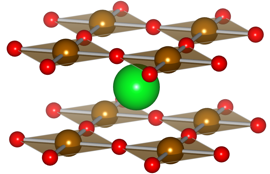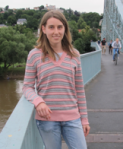Square planar ferrites: sneaking up on unlikely atomic geometries
What does it look like?

SrFeO2 (ICSD-173434) drawn with VESTA; green: Strontium atoms, brown: Iron atoms, red: Oxygen atoms.
What is it?
For years, chemists studying minerals and metal oxides have used "solid-state" reactions to make their compounds, forcing dry powders to react with each other by roasting them in furnaces at temperatures up to 1800 °C. The extreme conditions provide the atoms with enough energy to move about and form new crystal structures, but they also give the chemist limited control over the final product, because the atoms tend to settle into their "favourite" arrangements upon cooling. Now, scientists are exploring new methods for transforming crystals at lower reaction temperatures, where the atoms are unable to move as freely, as a way of creating unnatural and exotic crystal structures.
The "infinite layer" oxide SrFeO2, first reported in Nature by Tsujimoto and coworkers in 2007 [1], contains a very unusual structural feature: iron surrounded by four oxygen atoms in a square arrangement, each square sharing corners with its neighbours. These two-dimensional sheets of FeO2 are held apart by layers of strontium atoms, which sit in the "windows" of the square network. The reason it's considered a rarity is that iron almost always prefers a three-dimensional tetrahedral geometry when bonded to four oxygen atoms – in fact, the only natural mineral known to contain iron-oxygen squares is gillespite (BaFeSi4O10), whose squares are not networked but isolated from each other by rings of silica.
Tsujimoto et al. were able to create their remarkable iron oxide network by heating SrFeO3, a cubic perovskite, to a very modest 280 °C in the presence of calcium hydride (CaH2). The relatively low reaction temperature allowed the CaH2 to draw some oxygen out of the perovskite structure while the metals stayed in place. Voilà – a brand new ferrite! Similar methods have since produced a whole set of closely related structures containing calcium, cobalt and manganese [2,3], which have been studied for their interesting magnetic properties.
![SrFeO2 (below), created by the removal of selected oxygen atoms (in red) from the cubic perovskite SrFeO3 (above). Image source: Tsujimoto et al. [1]](https://www.iycr2014.org/__data/assets/image/0007/107179/squ_planer_2.png)
SrFeO2 (below), created by the removal of selected oxygen atoms (in red) from the cubic perovskite SrFeO3 (above). Image source: Tsujimoto et al. [1].
Where does it come from?
The above information was sourced from Tsujimoto’s Nature article [1] and the other references below. Images were generated using the structure file deposited in ICSD (Ref. 173434) by C. Tassel et al., J. Am. Chem. Soc. 130 (2008) pp. 3764-3765.
[1] Y. Tsujimoto et al, Nature, 450 (2007) pp. 1062-1066.
[2] C. Tassel et al., J. Am. Chem. Soc., 131 (2009) pp. 221-229.
[3] L. Seinberg et al., Inorg. Chem. 50 (2011) pp. 3988-3995.






